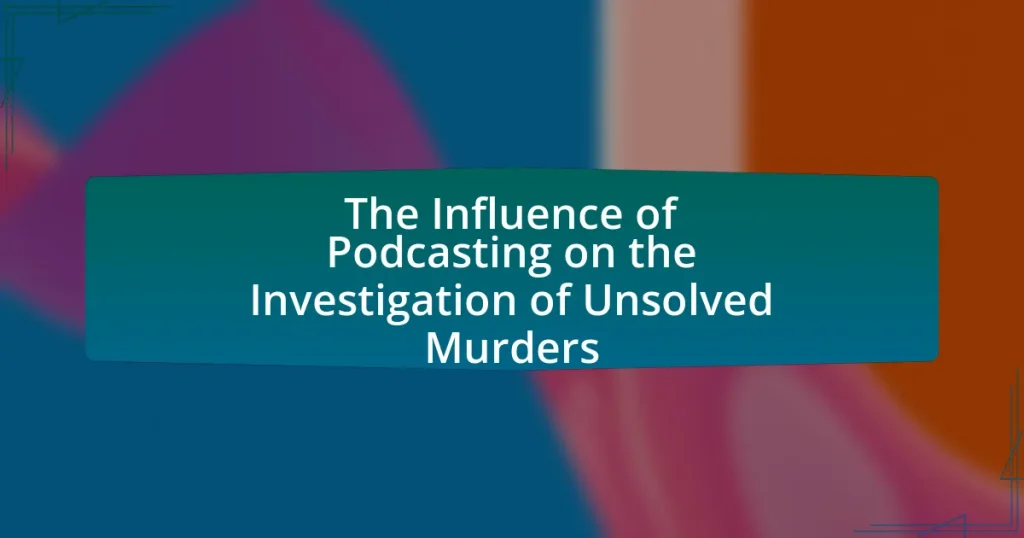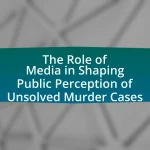Podcasting has emerged as a significant force in the investigation of unsolved murders, enhancing public awareness and generating new leads through in-depth storytelling and community engagement. Notable examples, such as the podcast “Serial,” have reignited interest in cold cases, prompting law enforcement to revisit evidence and pursue new avenues of investigation. This article explores how podcasts democratize access to information, facilitate public involvement, and impact law enforcement responses, while also addressing the ethical considerations and best practices for podcasters covering sensitive topics. Additionally, it highlights the psychological factors driving interest in unsolved murders and the narrative techniques that enhance listener engagement and participation in investigations.
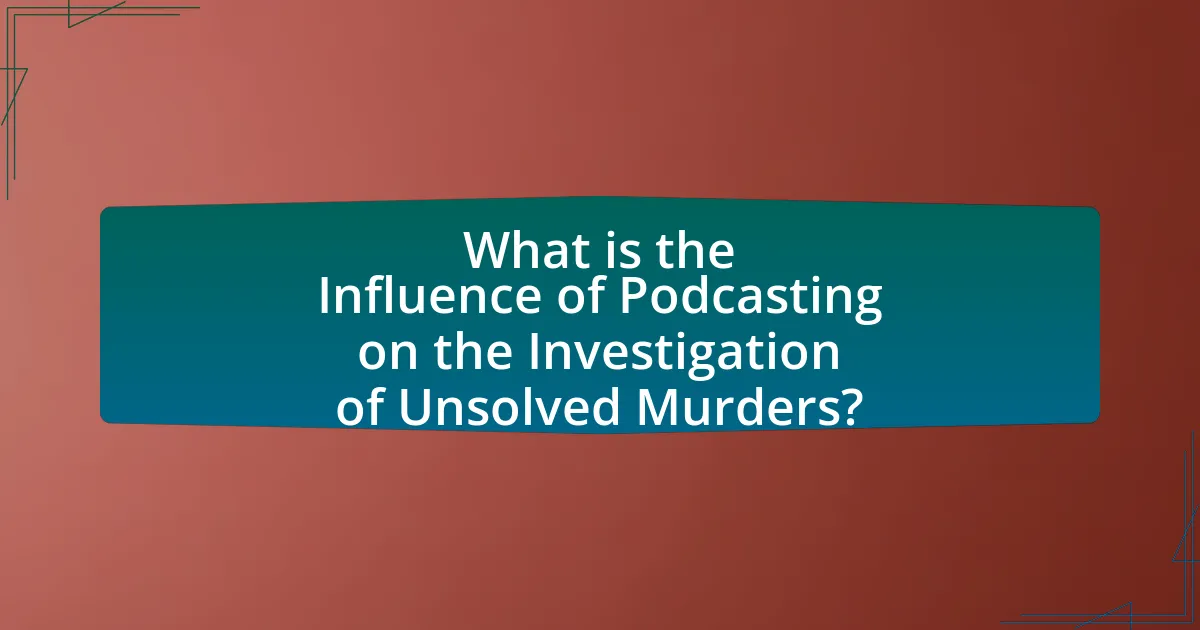
What is the Influence of Podcasting on the Investigation of Unsolved Murders?
Podcasting significantly influences the investigation of unsolved murders by raising public awareness and generating new leads. The format allows for in-depth storytelling, which can engage listeners emotionally and encourage them to share information. For instance, the podcast “Serial” brought renewed attention to the case of Adnan Syed, leading to further investigation and legal scrutiny. Additionally, podcasts often attract a dedicated audience that may include individuals with relevant information or expertise, thereby increasing the likelihood of uncovering new evidence. This phenomenon has been documented in various cases where public interest sparked by podcasts has led to police re-examinations of cold cases.
How has podcasting changed the landscape of crime investigation?
Podcasting has transformed the landscape of crime investigation by democratizing access to information and engaging a wider audience in unsolved cases. This medium allows for in-depth storytelling and analysis, which can generate public interest and pressure law enforcement to revisit cold cases. For instance, the podcast “Serial” significantly raised awareness about the Adnan Syed case, leading to renewed scrutiny and legal challenges. Additionally, podcasts often feature interviews with experts and witnesses, providing new insights and perspectives that can aid investigations. The interactive nature of podcasts encourages listener involvement, sometimes resulting in tips or leads that can assist law enforcement agencies.
What role do podcasts play in raising awareness about unsolved cases?
Podcasts play a significant role in raising awareness about unsolved cases by providing a platform for detailed storytelling and public engagement. They often present in-depth investigations, interviews with experts, and personal accounts from family members of victims, which can generate interest and empathy among listeners. For instance, the podcast “Serial” brought widespread attention to the case of Adnan Syed, leading to renewed public interest and legal scrutiny. This increased visibility can result in new leads, tips from the audience, and pressure on law enforcement to revisit cold cases, ultimately contributing to the potential resolution of unsolved crimes.
How do podcasts facilitate public engagement in investigations?
Podcasts facilitate public engagement in investigations by providing accessible platforms for storytelling and information sharing, which encourages audience participation and awareness. They often present detailed narratives about unsolved cases, allowing listeners to connect emotionally and intellectually with the content. This engagement can lead to increased public interest, prompting listeners to share information, tips, or insights that may assist law enforcement. For example, the podcast “Serial” significantly raised awareness about the Adnan Syed case, resulting in renewed public interest and legal scrutiny, which ultimately influenced the investigation’s trajectory.
Why are unsolved murders a significant focus for podcasters?
Unsolved murders are a significant focus for podcasters because they captivate audiences and create opportunities for community engagement in cold cases. The unresolved nature of these crimes generates intrigue and emotional investment, prompting listeners to explore the details and implications of each case. Additionally, podcasts can raise awareness and potentially lead to new tips or information, as evidenced by cases like the “Up and Vanished” podcast, which helped generate leads in the disappearance of Tara Grinstead. This combination of storytelling and audience involvement makes unsolved murders a compelling subject for podcasting.
What are the psychological and social factors driving interest in unsolved murders?
The psychological and social factors driving interest in unsolved murders include curiosity, the need for closure, and the social dynamics of storytelling. Curiosity about the unknown and the human psyche compels individuals to engage with unsolved cases, as they seek to understand the motivations behind criminal behavior. The need for closure arises from the unresolved nature of these cases, prompting a desire to find answers and justice for victims and their families. Additionally, social dynamics play a significant role; storytelling through media, particularly podcasts, fosters community engagement and shared interest, allowing listeners to connect emotionally and intellectually with the cases. Research indicates that the popularity of true crime content, including podcasts, has surged, reflecting a societal fascination with crime and the complexities of human behavior.
How do podcasters select which unsolved cases to cover?
Podcasters select unsolved cases to cover based on factors such as public interest, emotional impact, and the availability of information. They often analyze listener feedback, trending topics on social media, and the uniqueness of the case to gauge potential engagement. For instance, cases that have garnered significant media attention or have unresolved elements that evoke strong emotional responses tend to attract more listeners, making them appealing choices for podcasters. Additionally, the accessibility of case details, including police reports and interviews with family members or investigators, influences their selection process, ensuring they can provide a comprehensive narrative.
What impact do podcasts have on law enforcement and investigations?
Podcasts significantly impact law enforcement and investigations by raising public awareness and generating new leads in unsolved cases. They often attract a dedicated audience that engages with the content, leading to increased visibility for specific cases. For instance, the podcast “Serial” brought national attention to the 1999 murder of Hae Min Lee, prompting renewed interest and investigation into the case. Additionally, podcasts can facilitate community involvement, as listeners may provide tips or information that law enforcement can use to advance investigations. This collaborative dynamic between media and law enforcement can enhance the effectiveness of solving cold cases.
How do law enforcement agencies respond to information generated by podcasts?
Law enforcement agencies respond to information generated by podcasts by actively monitoring content for leads and tips related to unsolved cases. Agencies often utilize social media and online platforms to track discussions and insights shared by podcast hosts and listeners, which can provide new perspectives or previously unconsidered evidence. For instance, the podcast “Serial” led to renewed interest in the Adnan Syed case, prompting law enforcement to revisit evidence and witness statements. This demonstrates how podcasts can influence investigations by generating public interest and encouraging individuals with relevant information to come forward.
What are the potential risks and benefits of public involvement through podcasts?
Public involvement through podcasts presents both risks and benefits in the context of unsolved murder investigations. The primary benefit is the potential for increased awareness and engagement, which can lead to new tips or information from the public that may assist law enforcement. For instance, podcasts like “Serial” have successfully reignited interest in cold cases, resulting in new leads and public discourse surrounding the investigations.
Conversely, a significant risk is the possibility of misinformation spreading, which can mislead investigations or harm the reputations of individuals involved. For example, sensationalized narratives may create false perceptions about suspects or victims, complicating legal proceedings and public understanding. Additionally, public involvement can lead to undue pressure on law enforcement agencies, as they may feel compelled to act on every tip generated by podcast discussions, regardless of their validity.
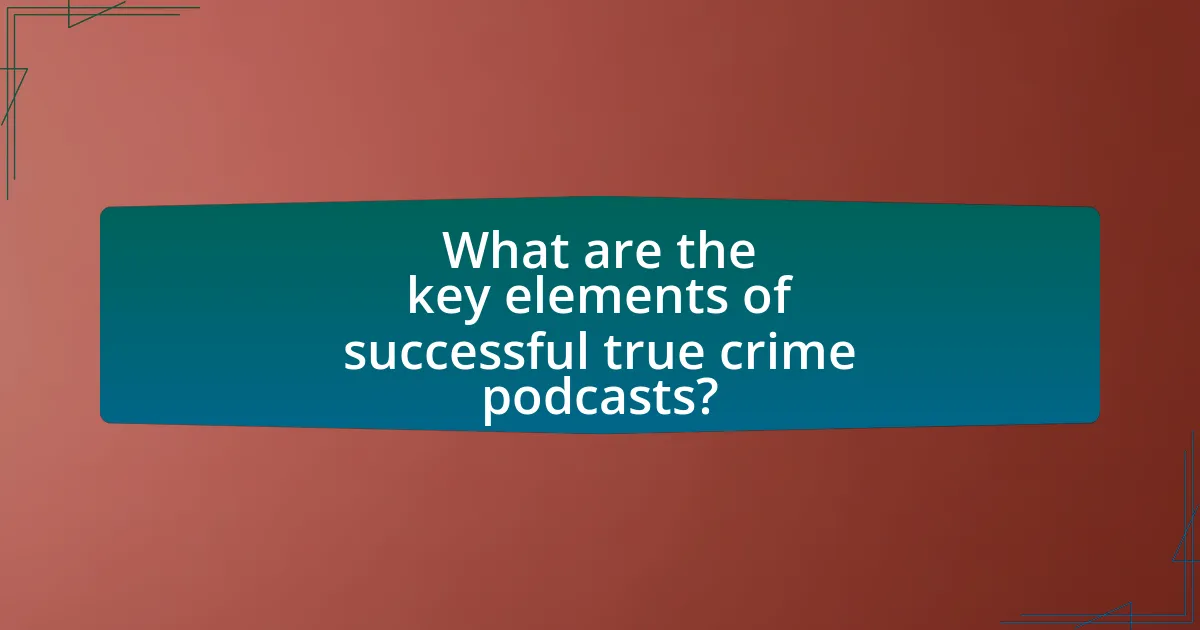
What are the key elements of successful true crime podcasts?
Successful true crime podcasts typically include compelling storytelling, thorough research, engaging hosts, and a strong emotional connection with the audience. Compelling storytelling captivates listeners by presenting the narrative in a way that is both intriguing and relatable, often using dramatic elements to enhance the experience. Thorough research ensures accuracy and credibility, as listeners expect factual information about the cases being discussed. Engaging hosts who can effectively communicate and connect with the audience enhance the listening experience, making the content more enjoyable and relatable. A strong emotional connection is crucial, as it allows listeners to empathize with the victims and their families, fostering a deeper investment in the story. These elements combined contribute to the overall success and popularity of true crime podcasts, as evidenced by the genre’s growth and listener engagement metrics.
How do storytelling techniques enhance the investigation of unsolved murders?
Storytelling techniques enhance the investigation of unsolved murders by creating engaging narratives that capture public interest and encourage community involvement. These techniques, such as character development, emotional appeal, and suspense, help to humanize victims and present the complexities of cases, making them more relatable to the audience. For instance, podcasts that utilize storytelling can reach wider audiences, leading to increased tips and information from listeners, which can be crucial in solving cases. Research indicates that storytelling in media can significantly impact public perception and engagement, as seen in successful true crime podcasts that have led to renewed investigations and breakthroughs in cold cases.
What narrative structures are most effective in true crime podcasts?
The most effective narrative structures in true crime podcasts include chronological storytelling, non-linear narratives, and immersive storytelling. Chronological storytelling presents events in the order they occurred, which helps listeners follow the timeline of the crime and investigation clearly. Non-linear narratives, on the other hand, create suspense by revealing information out of order, often using flashbacks or multiple perspectives to engage the audience. Immersive storytelling involves detailed descriptions and emotional engagement, allowing listeners to connect deeply with the victims and the circumstances surrounding the crime. These structures enhance listener engagement and retention, as evidenced by the popularity of podcasts like “Serial,” which employs a mix of these techniques to captivate its audience.
How do hosts build credibility and trust with their audience?
Hosts build credibility and trust with their audience by consistently providing accurate, well-researched content and engaging authentically with listeners. This involves thorough fact-checking and sourcing information from reputable sources, which enhances the reliability of the information shared. For instance, podcasts that discuss unsolved murders often reference law enforcement reports, court documents, and interviews with experts, thereby establishing a foundation of trust through transparency and accountability. Additionally, hosts who share personal experiences or demonstrate vulnerability can foster a deeper connection with their audience, further solidifying their credibility.
What role does research play in the production of true crime podcasts?
Research is essential in the production of true crime podcasts as it ensures accuracy, depth, and credibility in storytelling. Producers and hosts rely on thorough investigations of case files, court documents, and interviews with law enforcement and witnesses to present factual narratives. For instance, a study by the Pew Research Center highlights that 60% of podcast listeners value factual accuracy in content, underscoring the importance of research in maintaining audience trust. Additionally, well-researched podcasts often lead to renewed interest in cold cases, as evidenced by the success of shows like “Serial,” which prompted law enforcement to revisit unsolved murders based on the information presented.
How do podcasters gather and verify information about unsolved cases?
Podcasters gather and verify information about unsolved cases through extensive research, interviews, and collaboration with experts. They often utilize public records, police reports, and court documents to obtain factual data. Additionally, podcasters may reach out to law enforcement officials, family members of victims, and witnesses to gather firsthand accounts and insights. Verification is achieved by cross-referencing multiple sources to ensure accuracy and credibility. For instance, a study by the Pew Research Center highlights that 70% of podcast creators rely on interviews and expert opinions to substantiate their narratives, reinforcing the importance of diverse perspectives in the investigative process.
What ethical considerations must podcasters keep in mind during their research?
Podcasters must prioritize accuracy, consent, and sensitivity during their research. Accuracy is crucial to ensure that the information presented is factual and does not mislead the audience, as misinformation can harm individuals and communities involved in unsolved murder cases. Consent involves obtaining permission from individuals whose stories or experiences are being shared, particularly when discussing sensitive topics related to crime and personal trauma. Sensitivity is essential to approach the subject matter with care, respecting the feelings of victims’ families and communities affected by the crimes. Ethical guidelines, such as those outlined by the Society of Professional Journalists, emphasize the importance of minimizing harm and acting with integrity, reinforcing the need for podcasters to adhere to these principles in their research.
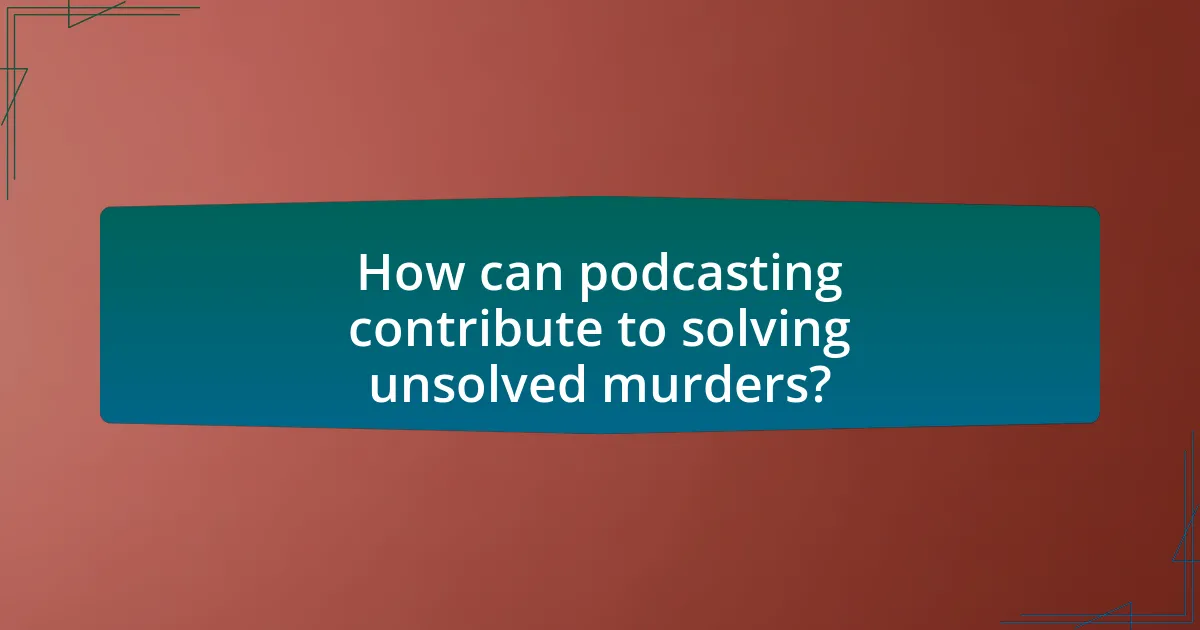
How can podcasting contribute to solving unsolved murders?
Podcasting can contribute to solving unsolved murders by raising public awareness and generating new leads through storytelling and investigative journalism. Podcasts often delve into the details of cold cases, attracting the attention of listeners who may have information or insights that could assist law enforcement. For example, the podcast “Serial” significantly impacted the public’s interest in the Adnan Syed case, leading to renewed scrutiny and legal developments. Additionally, podcasts can create a community of listeners who engage in discussions, share theories, and collaborate on investigations, further increasing the chances of uncovering new evidence or witnesses.
What are some notable cases where podcasts have led to breakthroughs?
Podcasts have led to breakthroughs in several notable unsolved murder cases, most prominently in the case of the murder of Hae Min Lee, which was re-examined in the podcast “Serial.” The podcast’s detailed investigation and public interest prompted law enforcement to revisit the evidence and ultimately led to the exoneration of Adnan Syed in 2022 after years of legal battles. Another significant case is the “Up and Vanished” podcast, which focused on the 2005 disappearance of Tara Grinstead. The podcast generated renewed interest and tips that contributed to the arrest of a suspect in 2017. These examples illustrate how podcasts can mobilize public engagement and influence law enforcement actions in cold cases.
How did public tips generated by podcasts influence specific investigations?
Public tips generated by podcasts have significantly influenced specific investigations by providing law enforcement with new leads and information. For instance, the podcast “Serial” led to renewed interest in the case of Adnan Syed, resulting in the Maryland Court of Appeals granting him a new trial in 2016 based on the emergence of new evidence and witness testimonies prompted by the podcast’s audience engagement. Additionally, the podcast “Crimetown” has been credited with uncovering details in cold cases, prompting police departments to revisit unsolved murders and actively seek public assistance. These examples illustrate how podcasts can mobilize public interest and generate actionable tips that directly impact ongoing investigations.
What lessons can be learned from successful podcast-led investigations?
Successful podcast-led investigations demonstrate the importance of thorough research, compelling storytelling, and community engagement. These elements contribute to uncovering new evidence and generating public interest, which can lead to renewed investigations. For instance, the podcast “Serial” significantly impacted the case of Adnan Syed by highlighting inconsistencies in the original investigation, prompting legal reviews and public discourse. Additionally, podcasts often mobilize listeners to share information or tips, as seen in “Crimetown,” which engaged local communities to assist in solving cases. These lessons underscore the effectiveness of combining investigative journalism with modern media to address unsolved murders.
What best practices should podcasters follow when covering unsolved murders?
Podcasters covering unsolved murders should prioritize accuracy, sensitivity, and ethical considerations. Accuracy is crucial; podcasters must verify facts and avoid speculation to prevent misinformation, as seen in cases where false narratives have hindered investigations. Sensitivity is essential when discussing victims and their families, ensuring respectful language and avoiding sensationalism. Ethical considerations include obtaining permission for interviews and respecting privacy, which aligns with journalistic standards. By adhering to these best practices, podcasters can contribute positively to the discourse surrounding unsolved murders while supporting ongoing investigations.
How can podcasters ensure they are respectful to victims and families?
Podcasters can ensure they are respectful to victims and families by prioritizing sensitivity in their content and approach. This includes obtaining consent from families before discussing sensitive topics, avoiding sensationalism, and focusing on factual reporting rather than speculation. Research indicates that respectful communication can foster trust and support among affected families, as seen in studies highlighting the importance of ethical journalism in crime reporting. By adhering to these principles, podcasters can contribute positively to the discourse surrounding unsolved murders while honoring the dignity of victims and their loved ones.
What strategies can enhance audience engagement and participation in investigations?
To enhance audience engagement and participation in investigations, utilizing interactive elements such as polls, Q&A sessions, and social media discussions is effective. These strategies allow audiences to contribute their thoughts and questions, fostering a sense of involvement. For instance, podcasts that incorporate listener feedback or case suggestions have shown increased listener retention and community building, as evidenced by the success of shows like “Serial,” which engaged audiences through social media platforms and encouraged them to share insights and theories. This interactive approach not only deepens audience investment but also enriches the investigative process by incorporating diverse perspectives.
